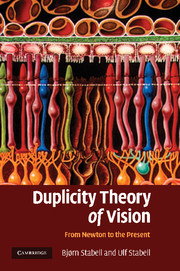Duplicity Theory of Vision From Newton to the Present
Langue : Anglais
Auteurs : Stabell Bjørn, Stabell Ulf

This book chronicles the development of three classic theories within vision research, from the 17th century to today, focusing on duplicity theory.
The duplicity theory of vision concerns the comparisons (both differences and similarities) and interaction between the cone and rod systems in the visual pathways, with the assumption that the cone system is active during daylight vision and the rod system functions in low light (night time). Research on this aspect of vision dates back to the 17th century and the work of Newton, and is still ongoing today. This book describes the origin and development of this fundamental theory within vision research - whilst also examining the Young?Helmholtz trichromatic colour theory, and the opponent colour theory of Hering - and presents evidence and ideas in light of modern conceptions of the theory. Written for academic researchers and graduate students, the book brings back knowledge of the tradition of duplicity theory, inspiring questions related to anatomy, comparative biology, molecular biology, photochemistry, physiology, genetics, phylogenetics and psychophysics.
1. Introduction; Part I. The Development of the Basic Ideas of the Duplicity Theory from Newton to G. E. Müller: 2. The Newton tradition; 3. The Schultze tradition; 4. The Goethe tradition. The phenomenological approach; 5. The colour theories of Armin Tschermak and George Elias Müller; Part II. The Development of the Duplicity Theory from 1930–66: 6. The duplicity theory of Polyak; 7. Investigations of H. K. Hartline and S. W. Kuffler; 8. The duplicity theory of R. Granit; 9. Contributions of E. N. Willmer, P. Saugstad & A. Saugstad, and I. Lie; 10. Status of the duplicity theory in the mid 1960s and its further development; Part III. Chromatic Rod Vision: An Historical Account: 11. Night vision may appear bluish; 12. Mechanisms of chromatic rod vision in scotopic illumination; 13. Rod-cone interactions in mesopic vision; 14. Contribution of J. J. McCann and J. L. Benton; 15. Contribution of P. W. Trezona; 16. Contribution of C. F. Stromeyer III; 17. Contribution of Steven Buck and co-workers; 18. Contribution of J. L. Nerger and co-workers; Part IV. Theories of Sensitivity Regulation of the Rod and Cone Systems: A Historical Account: 19. Introduction; 20. Early photochemical explanations; 21. Contribution of S. Hecht; 22. Contribution of G. Wald. Photochemical sensitivity regulation of rods and cones; 23. Relationship between amount of rhodopsin and sensitivity during dark adaptation; 24. Post-receptor sensitivity regulation mechanisms; 25. Rushton's A.G.C. model. Each receptor type has a separate and independent adaptation pool; 26. Are light and dark adaptation really equivalent?; 27. A decisive experiment; 28. The adaptation mechanisms explored by the after-flash technique; 29. Limitations of Rushton's photochemical theory; 30. Contribution of H. B. Barlow; 31. Rushton and Barlow compared; 32. Contribution of T. D. Lamb; 33. The Dowling-Rushton equation refuted; 34. Difference between rod and cone dark adaptation; 35. Light and dark adaptation are not equivalent; 36. Allosteric regulation of dark adaptation; 37. A search for the allosteric adaptation mechanisms; 38. Several mechanisms involved in sensitivity regulation; 39. Sensitivity regulation due to rod-cone interaction; 40. Modern conceptions of sensitivity regulation; Part V. Factors that Triggered the Paradigm Shifts in the Development of the Duplicity Theory: 41. Summary of K. R. Popper's and T. S. Kuhn's models of scientific development; 42. The development of the duplicity theory as a test of Popper's and Kuhn's models; 43. References.
Date de parution : 01-2013
Ouvrage de 238 p.
15.2x22.9 cm
Disponible chez l'éditeur (délai d'approvisionnement : 14 jours).
Prix indicatif 53,50 €
Ajouter au panierDate de parution : 08-2009
Ouvrage de 238 p.
15.6x23.5 cm
Thème de Duplicity Theory of Vision :
© 2024 LAVOISIER S.A.S.
